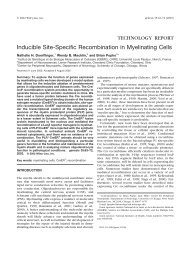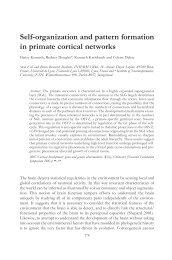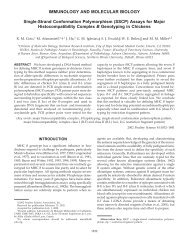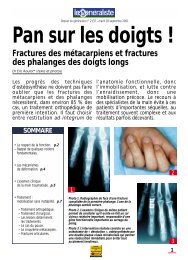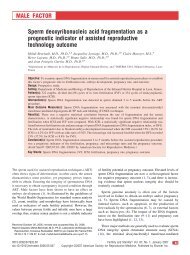Tancos et al. - Stem-cell and Brain Research Institute
Tancos et al. - Stem-cell and Brain Research Institute
Tancos et al. - Stem-cell and Brain Research Institute
Create successful ePaper yourself
Turn your PDF publications into a flip-book with our unique Google optimized e-Paper software.
2 Z. <strong>Tancos</strong> <strong>et</strong> <strong>al</strong>. / Theriogenology xx (2012) xxxKeywords: Rabbit; Pluripotency; Embryonic stem <strong>cell</strong>; Induced pluripotent stem <strong>cell</strong>Contents1. Introduction ................................................................................................................................ 22. Biology of pluripotency in rabbit ...................................................................................................... 22.1. <strong>Stem</strong> <strong>cell</strong> regulatory pathways in rabbits ..................................................................................... 22.2. Rabbit-specific pluripotency gene sequences ................................................................................ 32.3. MicroRNA regulation of stemness in the rabbit ............................................................................ 42.4. Antibodies (ABs) which work in the rabbit .................................................................................. 53. Technologies to reprogram rabbit somatic <strong>cell</strong>s to pluripotency .................................................................. 53.1. Nuclear transfer results <strong>and</strong> limitations in the rabbit ....................................................................... 53.2. Generation of rESC lines ........................................................................................................ 63.3. Generation of riPSC lines ....................................................................................................... 73.4. Chimera production with ESCs/iPSCs ........................................................................................ 94. Conclusion <strong>and</strong> the future .............................................................................................................. 104.1. Progress toward underst<strong>and</strong>ing pluripotency using systems biology; biomedic<strong>al</strong> applications will emerge ..... 10Acknowledgments ....................................................................................................................... 10References ...................................................................................................................................... 111. IntroductionThe rabbit is one of the most frequently used <strong>and</strong>relevant nonrodent species for modeling disease processes.The main biomedic<strong>al</strong> applications of gen<strong>et</strong>ic<strong>al</strong>lymodified organism rabbits are as models for hum<strong>and</strong>isease <strong>and</strong> in biopharming (live bioreactors) for thelarge sc<strong>al</strong>e production of pharmaceutic<strong>al</strong>ly importantproteins required for the treatment of human diseases.Recombinant protein expression in the milk of gen<strong>et</strong>ic<strong>al</strong>lymodified organism anim<strong>al</strong>s has been extensivelystudied in the past 25 yr, <strong>and</strong> has undergonesignificant recent improvements both from a m<strong>et</strong>hodologic<strong>al</strong>point of view <strong>and</strong> in terms of reaching themark<strong>et</strong>. In 2010, Pharming Group NV (Leiden, TheN<strong>et</strong>herl<strong>and</strong>s) received European approv<strong>al</strong> for a product(Ruconest) for treating acute attacks of hereditary angioedema;the drug which is now on the mark<strong>et</strong> isharvested from the milk of transgenic rabbits.The rabbit has an advantage over rodents in hum<strong>and</strong>isease modeling in that it is phylogen<strong>et</strong>ic<strong>al</strong>ly closer toprimates than the rodents [1] <strong>and</strong> large enough to permitnonl<strong>et</strong>h<strong>al</strong> monitoring of physiologic<strong>al</strong> changes. Forthese reasons, a number of research groups have chosentransgenic rabbits as models to study lipoprotein m<strong>et</strong>abolism<strong>and</strong> atherosclerosis. In this respect, the economic<strong>al</strong>lymost important chronic diseases of them<strong>et</strong>abolic syndrome complex: diab<strong>et</strong>es mellitus, hypertension,atherosclerosis, hyperlipidemia, <strong>and</strong> obesitycannot be adequately mimicked in mice. The rabbit is<strong>al</strong>so a more appropriate model than rodents for prenat<strong>al</strong>development <strong>and</strong> the long-lasting effects ofperturbations in the prenat<strong>al</strong> period on adult he<strong>al</strong>th<strong>and</strong> complex diseases. Similarities in biochemic<strong>al</strong><strong>and</strong> physiologic<strong>al</strong> processes, including placent<strong>al</strong>structure, b<strong>et</strong>ween human <strong>and</strong> rabbit make the latteran ex<strong>cell</strong>ent model for reproductive studies [2,3]. Inaddition, because rabbits have relatively large eyes,studies on the pathophysiology of r<strong>et</strong>in<strong>al</strong> degenerationusing the rabbit as a model have recently beenpublished [4]. Beyond that, transgenic rabbit modelsof human disorders connected to cardiac electrophysiology<strong>and</strong> hypertrophy have turned out to be extremelyuseful in pharmacogenomic studies <strong>and</strong> designof disease prevention programs [5].2. Biology of pluripotency in rabbit2.1. <strong>Stem</strong> <strong>cell</strong> regulatory pathways in rabbitsPluripotency <strong>and</strong> the capacity for self-renew<strong>al</strong> <strong>al</strong>lowembryonic stem <strong>cell</strong>s (ESCs) to either divide continuouslyin the undifferentiated state or to differentiate intoany somatic <strong>cell</strong> type. These characteristics are controlledby a number of <strong>cell</strong> sign<strong>al</strong>ing pathways <strong>and</strong>therefore depend on the provision of specific conditionsor factors. Rabbit embryonic stem <strong>cell</strong>s (rESC) resembleprimate ESCs more closely than mouse ESCs [6].The most important sign<strong>al</strong>ing pathways involved in themaintenance of pluripotency <strong>and</strong> the capacity for self-
Z. <strong>Tancos</strong> <strong>et</strong> <strong>al</strong>. / Theriogenology xx (2012) xxx3Fig. 1. A scheme illustrating the interactions among fibroblast growth factor (FGF), transforming growth factor (TGF), bone morphogen<strong>et</strong>icprotein (BMP), <strong>and</strong> Wnt sign<strong>al</strong>ing to sustain rabbit embryonic stem <strong>cell</strong>s (rESC) self-renew<strong>al</strong> (based on Wang <strong>et</strong> <strong>al</strong>. 2008 [6]).renew<strong>al</strong> in primate ESCs are fibroblast growth factor(FGF), which activates the mitogen-activated proteinkinase <strong>and</strong> Akt pathways <strong>and</strong> transforming growth factor(TGF)- which acts through Smad2/3/4. The Wntpathway <strong>al</strong>so supports pluripotency by activating-catenin. Sign<strong>al</strong>ing through these pathways results inthe activation <strong>and</strong> expression of three essenti<strong>al</strong> pluripotency-associatedtranscription factors: Oct4, Sox2,<strong>and</strong> Nanog. These factors are <strong>al</strong>l very important inmaintaining the pluripotent state of ESCs. The interactionb<strong>et</strong>ween Sox2 <strong>and</strong> Oct4 activates expression ofpluripotent-specific targ<strong>et</strong> genes <strong>and</strong> <strong>al</strong>so regulates theirown expression. Nanog is <strong>al</strong>so incorporated into theSox2-Oct4 complex, which is a transcription factorwith an essenti<strong>al</strong> role in maintaining the pluripotentstate of the inner <strong>cell</strong> mass (ICM) <strong>and</strong> of ESCs derivedfrom the ICM [7]. Nanog suppresses differentiation ofESCs toward the extraembryonic endoderm <strong>and</strong> trophectodermlineages. In interaction with Smad1, Nanoginhibits bone morphogen<strong>et</strong>ic protein (BMP)-inducedmesoderm differentiation of ESCs.However, the sign<strong>al</strong>ing pathways that regulate ESCpluripotency in the rabbit have not been definitivelyidentified. Wang <strong>et</strong> <strong>al</strong>. showed that inhibition of theTGF, FGF, <strong>and</strong> canonic<strong>al</strong> Wnt/catenin (Wnt) pathwaysresulted in the differentiation of rESC followed by downregulationof Smad2/3 phosphorylation <strong>and</strong> -catenin expression<strong>and</strong> upregulation of the phosphorylation ofSmad1 <strong>and</strong> catenin. Tog<strong>et</strong>her the FGF <strong>and</strong> TGF pathwaysplay important roles in the maintenance of pluripotencyby rESCs <strong>and</strong> in the activation of Smad2/3 <strong>and</strong>inhibition of Smad1/5/8 sign<strong>al</strong>ing. FGF activity dependson the TGF pathway, <strong>al</strong>though FGF <strong>al</strong>one <strong>al</strong>sohas effects directly or indirectly on the self-renew<strong>al</strong> ofrESCs. Wnt sign<strong>al</strong>ing has a less critic<strong>al</strong> role than theFGF <strong>and</strong> TGF pathways, but <strong>al</strong>so affects rESC state.Wang <strong>et</strong> <strong>al</strong>. showed that the TGF, FGF, <strong>and</strong> Wntpathways are required for rESC pluripotency <strong>and</strong> thatinhibition of mitogen-activated protein kinase/extra<strong>cell</strong>ularsign<strong>al</strong>-regulated kinase (ERK) <strong>and</strong> phosphoinositide3-kinase (PI3K)/AK mouse strain thymoma (AKT)sign<strong>al</strong>ing facilitates rESC differentiation [6] (Fig.1).2.2. Rabbit-specific pluripotency gene sequencesESCs <strong>and</strong> induced pluripotent stem <strong>cell</strong>s (iPSCs) arepluripotent <strong>cell</strong>s with the ability to differentiate intocomponents of <strong>al</strong>l three embryonic germ layers (ectoderm,endoderm, <strong>and</strong> mesoderm). There are a sm<strong>al</strong>lnumber of transcription<strong>al</strong> regulators, including Oct4,Sox2, <strong>and</strong> Nanog, that are centr<strong>al</strong> components of thispluripotency n<strong>et</strong>work. This n<strong>et</strong>work contributes to selfrenew<strong>al</strong><strong>and</strong> prevents differentiation. While promotingthe equipoised state of pluripotency, these factors <strong>al</strong>socontrol differentiation toward specific <strong>cell</strong> lineages [8–11]. Genes involved in maintaining the pluripotent <strong>cell</strong>state have been well characterized function<strong>al</strong>ly in themouse. However, little is known about the regulation ofself-renew<strong>al</strong> <strong>and</strong> pluripotency in rESCs <strong>and</strong> rabbitiPSCs (riPSCs).
4 Z. <strong>Tancos</strong> <strong>et</strong> <strong>al</strong>. / Theriogenology xx (2012) xxxThe importance of the pluripotency genes wasclearly demonstrated when, in 2006, Takahashi <strong>and</strong>Yamanaka [12] identified four factors which, whencotransfected <strong>and</strong> expressed in mouse adult fibroblast<strong>cell</strong>s, caused those <strong>cell</strong>s to revert to the pluripotentstate. These four factors were:1. POU (Pituitary-specific Pit-1, Octamer transcriptionfactor proteins Oct-1 <strong>and</strong> Oct-2, neur<strong>al</strong>Unc-86 transcription factor from Caenorhabditiselegans) class 5 homeobox (1Oct4/Pou5f1) encodedby the gene pou5f1 (POU domain, class 5,transcription factor 1); a transcription factor expressedin undifferentiated ESCs. Oct4 expressionis critic<strong>al</strong> to the maintenance of the pluripotentstate.2. SRY (sex-d<strong>et</strong>ermining region Y)-box containinggene 2 (Sox2) is another transcription factor critic<strong>al</strong>for the maintenance of pluripotency. It acts inpar<strong>al</strong>lel with Oct4 in regulating the expression oftarg<strong>et</strong> genes involved in the maintenance of pluripotency.3. v-myc myelocytomatosis vir<strong>al</strong> oncogene homolog(c-Myc) is a well known proto-oncogene.This gene encodes a transcription factor that controlsthe expression of genes involved in theregulation of <strong>cell</strong> proliferation, growth, differentiation,apoptosis, <strong>and</strong> m<strong>al</strong>ignant transformation.4. Krüppel-like factor 4 (Klf-4) is a transcriptionfactor expressed in undifferentiated ESCs. It is<strong>al</strong>so expressed in specific <strong>cell</strong>s in the adult organism,including <strong>cell</strong>s in the gut, testis, <strong>and</strong>lungs. It regulates proliferation, differentiation,<strong>and</strong> <strong>cell</strong> surviv<strong>al</strong>.Although Nanog does not belong to the origin<strong>al</strong> four“Yamanaka factors”, is <strong>al</strong>so an important pluripotencyfactor that acts tog<strong>et</strong>her with Oct4 <strong>and</strong> Sox2 in establishingESC identity. Besides this, Nanog is downstreamof Klf4 <strong>and</strong> is switched on by the four factorsduring iPSC reprogramming.One approach to identifying putative rabbit pluripotencygenes is based on phylogen<strong>et</strong>ic sequence comparisonamong species. Using basic loc<strong>al</strong> <strong>al</strong>ignmentsearch tool (BLAST) searches against public databases,the homologues of sever<strong>al</strong> mamm<strong>al</strong>ian pluripotencygenes (Nanog, Oct4, Klf4, c-Myc, Sox2) have beenidentified. Another approach to identifying c<strong>and</strong>idatepluripotency factors is to perform a search in the RabbitGenome Resource Database, because the sequencing ofthe rabbit genome is nearly compl<strong>et</strong>e. These databaseshave yielded parti<strong>al</strong> <strong>and</strong>/or full rabbit Nanog, Oct4,c-Myc, <strong>and</strong> Sox2 sequences. The gene sequences foundin the Rabbit Genome Resource Database show differentdegrees of homology to the mouse <strong>and</strong> humanorthologs. Those for Oct4 <strong>and</strong> c-Myc are relativelyclose, while Nanog differs more at both the nucleic <strong>and</strong>amino acid levels [13]. The identified differences mightexplain the difficulties encountered using human ormurine cytokines to establish rESC <strong>and</strong> riPSC that arecapable of germ line transmission via chimera production.2.3. MicroRNA regulation of stemness in the rabbitRecent studies have indicated that microRNAs(miRNAs), a class of noncoding endogenous sm<strong>al</strong>lRNA molecules, participate in posttranscription<strong>al</strong> regulationof gene expression <strong>and</strong> play a key role in stem<strong>cell</strong> self-renew<strong>al</strong> <strong>and</strong> differentiation [14]. ESC-specificmiRNAs are abundant in pluripotent stem <strong>cell</strong>s, butdisappear rapidly during differentiation [14,15]. ThemiR290-295 cluster is expressed during early embryogenesis<strong>and</strong> is function<strong>al</strong>ly important in mouse ESCs<strong>and</strong> embryonic carcinoma <strong>cell</strong>s [14]. Overexpression ofmiR290-295 prevents ESCs from embarking on differentiation,probably by preventing ESCs accumulatingin the G1 phase [16]. The miR302-367 cluster is <strong>al</strong>sohighly expressed in both human <strong>and</strong> murine ESCs, <strong>and</strong>downregulated upon differentiation [17]. In addition,DGCR8 <strong>and</strong> Dicer knockout studies indicate thatmiRNA pathways have a key regulatory function inESC self-renew<strong>al</strong> <strong>and</strong> pluripotency [18]. Moreover, theESC-specific miRNA promoters are regulated by Oct4,Sox2, <strong>and</strong> Nanog [19–22]. The ESC-specific miRNAscan directly targ<strong>et</strong> these transcription factors, establishinga complex feedback loop, which is a key regulatorof pluripotency [22]. A recent study on iPSC derivationshows that expression of the miR302-367 cluster rapidly<strong>and</strong> efficiently reprograms mouse <strong>and</strong> human somatic<strong>cell</strong>s to an iPSC state without the requirement forexogenous transcription factors, <strong>and</strong> that it is even moreefficient than the st<strong>and</strong>ard Oct4/Sox2/Klf4/Myc-mediatedm<strong>et</strong>hod [23]. Other reports show that c-Myc replacementby miR-294 can enhance the reprogrammingof somatic <strong>cell</strong>s to iPSCs [24]. Based on these studies,we aimed to characterize rabbit stem-like <strong>cell</strong> specificmiRNAs. We observed high expression of miR302a,miR302b, <strong>and</strong> miR367, whereas miR-290, miR-292,<strong>and</strong> miR-294 were expressed at lower levels in rESCs.We could not d<strong>et</strong>ect the expression of the miR371-373cluster in rabbit ESCs. The SOLiD Sequencing System<strong>al</strong>lowed us to identify numerous miRNAs that appear tobe specific to rESCs. The newly described miRNAs
Z. <strong>Tancos</strong> <strong>et</strong> <strong>al</strong>. / Theriogenology xx (2012) xxx5have <strong>al</strong>ready been v<strong>al</strong>idated on rabbit embryos <strong>and</strong>ESCs (Maraghechi <strong>et</strong> <strong>al</strong>., manuscript in preparation).Further profiling of the rabbit ESC-specific miRNAsignature is expected to help solve the problems encounteredduring rabbit ESC <strong>and</strong> iPSC derivation.2.4. Antibodies (ABs) which work in the rabbitRabbit ESCs <strong>and</strong> iPSCs morphologic<strong>al</strong>ly resemblehuman ESCs; however, their proliferation characteristicsmore closely resemble those observed for mouseESCs. Differences were <strong>al</strong>so identified when the <strong>cell</strong>lines were studied for pluripotency markers by immunocytochemistry.The possible explanations for the differencesobserved include both technic<strong>al</strong> <strong>and</strong> biologic<strong>al</strong>elements, such as the absence of specific ABs raisedagainst rabbit putative pluripotency protein sequences;<strong>and</strong> the varying degree of homology b<strong>et</strong>ween the human<strong>and</strong> rabbit amino acid sequences used to raise theABs. The ABs used for characterizing rESCs <strong>and</strong>riPSCs have <strong>al</strong>l been raised against human protein sequences.This is because the homology b<strong>et</strong>ween human<strong>and</strong> rabbit pluripotency marker sequences appears to behigh despite the absence of compl<strong>et</strong>e, exact rabbit pluripotencygene sequence information. Because it is difficultto generate appropriate rabbit proteins, the use ofthe commerci<strong>al</strong>ly available ABs raised against humanpluripotency markers is the “next best” option, butthere are inevitable failures of cross-reactivity. Themost frequently used ABs to d<strong>et</strong>ect Oct4 are thoseproduced commerci<strong>al</strong>ly by Santa Cruz Biotechnology[25–27] <strong>and</strong> Chemicon [10]. The AB from Santa CruzBiotechnology is a goat polyclon<strong>al</strong> AB raised against apeptide mapping near the N-terminus of human Oct4<strong>and</strong> that is specific for the nuclear loc<strong>al</strong>ized Oct4Aisoform. This AB exhibits strong positive staining forOct4 with a nuclear loc<strong>al</strong>ization. By contrast, theChemicon AB is an anti-Oct4 mouse monoclon<strong>al</strong> ABraised against a recombinant protein corresponding toamino acids 143 to 359 of human Oct4 <strong>and</strong> that d<strong>et</strong>ectsboth nuclear (Oct4A) <strong>and</strong> cytoplasmic (Oct4B) isoforms,as demonstrated by Wang, <strong>et</strong> <strong>al</strong>. [10]. In the caseof the stage-specific embryonic antigen-1 (SSEA1),which is one of the most important ESC markers, morecontradictory results have been published. The mostfrequently used ABs for this surface marker are thosefrom Development<strong>al</strong> Studies Hybridoma Bank (DSHB)described by Honda <strong>et</strong> <strong>al</strong>. [26,28], who generated thefirst riPSC lines, <strong>and</strong> that from Chemicon which wasused by Wang <strong>et</strong> <strong>al</strong>. [10] <strong>and</strong> by Intawicha <strong>et</strong> <strong>al</strong>. [27].Honda <strong>et</strong> <strong>al</strong>. [26,28] <strong>and</strong> Wang <strong>et</strong> <strong>al</strong>. [10] showedpotenti<strong>al</strong>ly positive immunostaining for SSEA1. Bycontrast, Intawicha <strong>et</strong> <strong>al</strong>. [27] did not observe positivestaining for SSEA1 using the same AB as Wang<strong>et</strong> <strong>al</strong>. [10]. One possible explanation for the inconsistentresults might be sample preparation: the presenceor absence of d<strong>et</strong>ergents like Tween 20 in the blockingsolution. Tween 20 is a nonionic d<strong>et</strong>ergent that is nonselectivein nature <strong>and</strong> may extract proteins <strong>al</strong>ong withthe lipids [29–30], making the membranes permeabl<strong>et</strong>o ABs. The ABs against the membrane markersSSEA4, Tra-1-60 <strong>and</strong> Tra-1-81, which are <strong>al</strong>so oftenused to characterize ESCs <strong>and</strong> iPSCs, are available bothfrom Chemicon <strong>and</strong> DSHB <strong>and</strong> both s<strong>et</strong>s achieve theexpected membrane staining. In the case of Nanog,there are two different s<strong>et</strong>s of ABs used regularly: thefirst one is distributed by Cosmobio, Japan <strong>and</strong> wasused by Honda <strong>et</strong> <strong>al</strong>. [26] <strong>and</strong> the other is provided byAbcam <strong>and</strong> was used by Intawicha <strong>et</strong> <strong>al</strong>. [27]. The latterAB did not work well according to the published data,<strong>and</strong> since that publication its production has been discontinued.Thus, based on available publications the ABs thatcan be used to effectively characterize rESC <strong>and</strong> riPSCsare those against Oct4 (from Santa Cruz Biotechnology<strong>and</strong> Chemicon), Nanog (from Cosmobio <strong>and</strong> Abcam),SSEA1, SSEA4, Tra-1-60, <strong>and</strong> Tra-1-81 (from Chemicon<strong>and</strong> DSHB). Over<strong>al</strong>l, this suggests that it would behelpful to produce rabbit-specific ABs raised againstrabbit protein sequences, thereby emphasizing the needto clone rabbit specific cDNAs. This would make itfeasible to test <strong>and</strong> produce ABs which work in therabbit, <strong>and</strong> could open up further possibilities towardusing the rabbit as a model system for human development<strong>and</strong> disease.3. Technologies to reprogram rabbit somatic <strong>cell</strong>sto pluripotency3.1. Nuclear transfer results <strong>and</strong> limitations in therabbitReprogramming of somatic <strong>cell</strong>s to pluripotency canbe achieved by nuclear transfer (NT) into enucleatedoocytes. Compared with norm<strong>al</strong> fertilized preimplantationembryos, somatic <strong>cell</strong> nuclear transfer (SCNT)-derived embryos have the added ch<strong>al</strong>lenge of silencingtheir somatic-specific genes while reactivating <strong>al</strong>l theembryo-related genes <strong>and</strong> pathways. In this respect,SCNT is a powerful tool for improving our underst<strong>and</strong>ingof the sign<strong>al</strong>ing pathways involved in pluripotency<strong>and</strong> differentiation.In the late 1980s <strong>and</strong> during the 1990s, the rabbitwas one of the mamm<strong>al</strong>ian species in which investiga-
6 Z. <strong>Tancos</strong> <strong>et</strong> <strong>al</strong>. / Theriogenology xx (2012) xxxtors pioneered nuclear transfer technologies, in particularwhen the first embryonic clones were produced byintroducing rabbit embryonic <strong>cell</strong> nuclei (blastomeresfrom 8- to 16-<strong>cell</strong> stage embryos) into enucleatedoocytes [31–34]. Since the first mamm<strong>al</strong>s were produced[35] by SCNT, many species have been clonedusing this technology. Nevertheless, when differentiatedsomatic <strong>cell</strong>s were used as donor <strong>cell</strong>s for SCNT inthe rabbit, it was found that this species was relativelydifficult to clone when compared with other mamm<strong>al</strong>s.It was not until 2002 that the first rabbits cloned bySCNT, using freshly prepared adult rabbit cumulus<strong>cell</strong>s as donor <strong>cell</strong>s, were born [36,37]. Since then onlya few other groups have published successful generationof cloned live rabbits using somatic donor <strong>cell</strong>s orstem <strong>cell</strong>s [38–41], these did however include transgenicrabbits expressing green fluorescent protein[41,42]. Although a good proportion (up to 55%) ofreconstructed embryos develops to the blastocyst stage,the development to term after embryo transfer is low(average 2%). A b<strong>et</strong>ter development to term rate wasobtained when multipotent stem <strong>cell</strong>s were used asdonor <strong>cell</strong>s (4%) [41]. Nevertheless, relatively few resultedin live offspring <strong>and</strong> fewer still survived to sexu<strong>al</strong>maturity; according to published data collected byZakhartchenko <strong>et</strong> <strong>al</strong>. [41], from 42 cloned rabbits born<strong>al</strong>ive, only 17 reached sexu<strong>al</strong> maturity [36–40]. Thegreatest number of cloned rabbits surviving to adulthood(eight) was reported by Meng <strong>et</strong> <strong>al</strong>. [40] usingcumulus <strong>cell</strong>s as nuclear donors.Successful nuclear reprogramming from somatic topluripotent status is the key event in NT, <strong>and</strong> dependson the epigen<strong>et</strong>ic status of the nucleus. There is thereforea reason why <strong>cell</strong>s with high genome plasticitypotenti<strong>al</strong> (mesenchym<strong>al</strong> stem <strong>cell</strong>s) might be b<strong>et</strong>ternuclear donors than more differentiated <strong>cell</strong> types. Inthe case of rabbit NT, putative ESCs [25] or iPSCs [26],may be even more successful donor <strong>cell</strong>s for NT. Studies[40,43] have <strong>al</strong>so investigated the use of TrichostatinA (TSA; a histone deac<strong>et</strong>ylase inhibitor) to examin<strong>et</strong>he effect of m<strong>et</strong>hylation changes on nuclear reprogramming.In the rabbit, the mechanism <strong>and</strong> the longtermeffects of TSA treatment on postimplantation <strong>and</strong>postpartum development require further studies, notleast because in the studies of Meng <strong>et</strong> <strong>al</strong>. [40] <strong>al</strong>l theTSA-treated anim<strong>al</strong>s died within 19 days, while amongthe non–TSA-treated SCNT anim<strong>al</strong>s a reasonable proportionsurvived to adulthood <strong>and</strong> gave birth to he<strong>al</strong>thyprogeny. In the case of the rabbit, progress <strong>and</strong> difficultiesencountered during the SCNT procedure mightbe informative for identifying the critic<strong>al</strong> factors implicatedin reprogramming defects.3.2. Generation of rESC linesOver the past 5 yr, four independent groups havereported the establishment of rESC (or ESC-like) lines(Table 1A) [10,25,41,44–49]. Rabbit ESCs exhibit thecardin<strong>al</strong> features of pluripotent stem <strong>cell</strong>s: the capacity toself-renew indefinitely (or at least for a large number ofpassages) in vitro under appropriate culture conditions,<strong>and</strong> to differentiate into speci<strong>al</strong>ized <strong>cell</strong>s of ectoderm<strong>al</strong>,mesoderm<strong>al</strong>, <strong>and</strong> endoderm<strong>al</strong> origins. Like their murine<strong>and</strong> primate counterparts, rESCs <strong>al</strong>so have the capacityto form teratomas when injected into an immunodeficientmouse. One key factor in the derivation of rESClines appears to be the density of feeder <strong>cell</strong>s [25].Using the conditions described by Honda <strong>and</strong> colleagues[26], we could derive sever<strong>al</strong> rESC lines. All ofthem displayed unlimited growth (until passage 50) <strong>and</strong>ability to differentiate into the three germ layers (Osteil<strong>et</strong> <strong>al</strong>. manuscript in preparation). Rabbit ESCs grow inflat colonies, resembling the colonies of primate (human<strong>and</strong> nonhuman) ESCs. They can be passaged aftercollagenase treatment followed by gentle dissociation(Osteil <strong>et</strong> <strong>al</strong>., unpublished data). It has been shown thatboth FGF2, through ERK <strong>and</strong> PI3K activation, <strong>and</strong>Activin/Nod<strong>al</strong> sign<strong>al</strong>ing, through Smad2/3 activation,are necessary to maintain the pluripotent status ofrESCs [6,28]. The question of wh<strong>et</strong>her rESCs <strong>al</strong>sorequire leukemia inhibitory factor (LIF)-sign<strong>al</strong>ing forself-renew<strong>al</strong> is controversi<strong>al</strong>. Studies performed byHonda <strong>and</strong> colleagues demonstrated that treatment witha janus kinase (JAK) kinase inhibitor, resulting in theloss of phosphorylated sign<strong>al</strong> transducer <strong>and</strong> activatorof transcription-3 (STAT3), had no effect on self-renew<strong>al</strong>[28]. By contrast, the results of studies performedwith ESC lines derived from parthenogen<strong>et</strong>ic<strong>al</strong>lyactivated rabbit embryos suggested that both LIF<strong>and</strong> FGF2 were capable of sustaining self-renew<strong>al</strong>, <strong>and</strong>that the two factors could act cooperatively to supportstemness in the absence of feeder <strong>cell</strong>s [27,50]. TherESC lines isolated in our laboratory do not require LIFto ensure a blockade to differentiation. However, therequirement, either of autocrine LIF sign<strong>al</strong>ing, or ofparacrine LIF sign<strong>al</strong>ing involving the feeder <strong>cell</strong>s, actingin synergy with FGF2 sign<strong>al</strong>ing cannot be excluded(Osteil <strong>et</strong> <strong>al</strong>., unpublished).In an effort to generate rESCs capable of selfrenew<strong>al</strong>in the naive state of pluripotency, ICM <strong>cell</strong>swere plated on feeder <strong>cell</strong>s in N2/B27 medium supplementedwith LIF, ERK (PD03225901), <strong>and</strong> GSK-3
Z. <strong>Tancos</strong> <strong>et</strong> <strong>al</strong>. / Theriogenology xx (2012) xxx7(CHIR99021) inhibitors (2 inhibitors LIF medium),according to the protocol described previously formouse <strong>and</strong> rat ESC derivation [51,52]. As described forrodents [53], rabbit embryos were <strong>al</strong>so treated withPD0325901 to promote the growth of pluripotent stem<strong>cell</strong>s. Most ICMs from treated <strong>and</strong> nontreated embryosgave rise to primary outgrowths when plated. No differencewas observed b<strong>et</strong>ween outgrowths originatingfrom PD0325901-treated <strong>and</strong> control embryos <strong>and</strong>none of them could be passaged more than once. Theseresults indicate that pluripotent stem <strong>cell</strong>s derived fromrabbit ICM are not capable of self-renew<strong>al</strong> in the cultureconditions described previously for rodents.As indicated above, ingredients of the media formaintaining stable rESC lines differ b<strong>et</strong>ween laboratories.The basic medium in most cases is Dulbecco’sModified Eagles Medium (DMEM) or supplementedversions thereof, such as DMEM/F12 or Knock-OutDMEM. The common ingredients are glutamine, -mercapto<strong>et</strong>hanol <strong>and</strong> nonessenti<strong>al</strong> amino acids. Withregard to the specific supplements, most researchgroups use either LIF or FGF2, which is why thequestion of wh<strong>et</strong>her rESCs require one or both of thesefactors is still controversi<strong>al</strong>. The situation is similarwith respect to serum content; the medium may containf<strong>et</strong><strong>al</strong> c<strong>al</strong>f serum or Knock-Out Serum Replacement. Todate there is no consensus about what m<strong>et</strong>hod or solutionsare the most effective for the establishment ofrESCs.3.3. Generation of riPSC linesGeneration of iPSCs from somatic <strong>cell</strong>s demonstratesthat adult mamm<strong>al</strong>ian <strong>cell</strong>s can be reprogrammedto a pluripotent state by treating them withfour major factors. iPSC technology is a unique tool forderiving specific stem <strong>cell</strong>s to study disease <strong>and</strong> fordeveloping possible treatments for degenerative disorders.iPSCs can be promising tools for drug screening,toxicology testing, <strong>and</strong> for generating knockout ortransgenic anim<strong>al</strong> models. The first iPSCs were generatedby r<strong>et</strong>rovir<strong>al</strong> vector transduction using c-Myc,Klf4, Oct4, <strong>and</strong> Sox2 [12,54–56]. The disadvantage ofthe r<strong>et</strong>rovir<strong>al</strong> system is that it stably integrates into thehost genome, causing m<strong>al</strong>ignant transformations in chimericanim<strong>al</strong>s [55]. The application of a constitutivelyactive lentivirus system could not overcome this drawbackbecause it was even less efficiently silenced inpluripotent <strong>cell</strong>s than r<strong>et</strong>rovir<strong>al</strong> vectors [57,58]. Thenext generation of the lentivir<strong>al</strong> system is representedby the inducible lentivir<strong>al</strong> vector, in which the expressionis regulated by doxycycline. Drug resistance influencesthe expression of the transgene, reducing the riskof constitutive expression, <strong>and</strong> providing a selectiontool for reprogrammed iPSCs [57,59]. Lentivir<strong>al</strong> vectorshave become more efficient than r<strong>et</strong>rovir<strong>al</strong> vectorsat infecting different somatic <strong>cell</strong> types <strong>and</strong> can be usedto express polycistronic cass<strong>et</strong>tes encoding <strong>al</strong>l four reprogrammingfactors [60,61]. The best solution giventhe requirements of saf<strong>et</strong>y for eventu<strong>al</strong> therapy is thegeneration of integration-free iPSCs. Techniques usedto generate integration-free iPSCs can be divided intothree categories: (1) m<strong>et</strong>hods using nointegrating vectors,(2) m<strong>et</strong>hods using integrating vectors that can beremoved from the genome, <strong>and</strong> (3) m<strong>et</strong>hods that do notuse nucleic acid-based vectors at <strong>al</strong>l. Sever<strong>al</strong> laboratorieshave developed integration-dependent gene deliveryvectors containing loxP sites permitting the excisionof a transgene by Cre-recombinase [62,63]. Forexample, PiggyBac [64,65] <strong>and</strong> Sleeping Beauty transposons[66–68] can be introduced into the host genome<strong>and</strong> removed by the transposase or a cre-lox system.Successful reprogramming was <strong>al</strong>so achieved by deliveringthe reprogramming factors as purified recombinantproteins [69], or using synth<strong>et</strong>ic modified messengerRNA (mRNA) [70] <strong>and</strong> miRNA [23]. In human <strong>and</strong>murine <strong>cell</strong>s, these technologies <strong>al</strong>ready work to someextent. Using a vari<strong>et</strong>y of m<strong>et</strong>hods, iPSCs have nowbeen derived from sever<strong>al</strong> different species: mouse[12,64,65] human [23,63,70–73], rat [74], rhesus monkey[75], dog [76], horse [77], <strong>and</strong> pig [78]. Honda <strong>et</strong><strong>al</strong>. [26] were the first group to report the establishmentof riPSC lines which they produced from adult rabbitliver <strong>and</strong> stomach <strong>cell</strong>s using lentivir<strong>al</strong> vectors carryingthe human reprogramming genes: c-Myc, Klf4, Sox2,<strong>and</strong> Oct4 (Table 1B). The newly generated riPSCsresembled human iPSCs; they formed flattened colonieswith sharp edges <strong>and</strong> proliferated indefinitely inthe presence of FGF2. They expressed the endogenouspluripotency markers c-Myc, Klf4, Sox2, Oct4, <strong>and</strong>Nanog, while the exogenous human genes were compl<strong>et</strong>elysilenced. In vitro, riPSCs rapidly differentiatedinto ectoderm, mesoderm, <strong>and</strong> endoderm. In vivo theyformed teratomas, but they were unable to form chimeras.Thus, the newly generated rabbit iPSCs fulfilled <strong>al</strong>lrequirements of pluripotency, except the chimera test.However, glob<strong>al</strong> gene expression an<strong>al</strong>ysis reve<strong>al</strong>edslight, but definite differences b<strong>et</strong>ween ESCs <strong>and</strong>iPSCs.We generated riPSC lines by using r<strong>et</strong>rovir<strong>al</strong> vectorsto introduce the human reprogramming genes(c-Myc, Klf4, Sox2, <strong>and</strong> Oct4) into adult rabbit earfibroblasts. The resulting <strong>cell</strong>s exhibited the cardin<strong>al</strong>
8 Z. <strong>Tancos</strong> <strong>et</strong> <strong>al</strong>. / Theriogenology xx (2012) xxxTable 1Published studies on establishment of pluripotent stem <strong>cell</strong> lines from rabbit.YearReferenceNumberTitleA. Embryonic stem <strong>cell</strong> lines1993 [46] Derivation <strong>and</strong> characterizationof putative pluripotenti<strong>al</strong>embryonic stem <strong>cell</strong>s frompreimplantation rabbit embryos1996 [47] Pluripotenti<strong>al</strong> rabbit embryonicstem (ES) <strong>cell</strong>s are capable offorming overt coat colorchimeras following injectioninto blastocysts2006 [44] Rabbit embryonic stem <strong>cell</strong>lines derived from fertilized,parthenogen<strong>et</strong>ic or somatic <strong>cell</strong>nuclear transfer embryos2007 [10] Generation <strong>and</strong>characterization of rabbitembryonic stem <strong>cell</strong>s2008 [48] Culture <strong>and</strong> characterization ofpresumptive embryonic stem<strong>cell</strong> line isolated from NewZe<strong>al</strong><strong>and</strong> White rabbit embryos2008 [49] Characterization, chromosom<strong>al</strong>assignment, <strong>and</strong> role of LIFRin early embryogenesis <strong>and</strong>stem <strong>cell</strong> establishment ofrabbits2008 [25] Stable embryonic stem <strong>cell</strong>lines in rabbits: potenti<strong>al</strong> sm<strong>al</strong>lanim<strong>al</strong> models for humanresearchSpeci<strong>al</strong>supplements inthe mediaMurine leukemiainhibitory factorMurine leukemiainhibitory factorHumanrecombinantbasic fibroblastgrowth factorNosupplementedspeci<strong>al</strong> factorMurine leukemiainhibitory factorMurine leukemiainhibitory factor,humanrecombinantbasic fibroblastgrowth factorMurine leukemiainhibitory factor;humanrecombinantbasic fibroblastgrowth factorMarkers testedDesminAPAP, SSEA-1,SSEA-3, SSEA-4, TRA-1-10,TRA-1-81, Oct-4, EBAF, FGF4,TDGF1, ß-Tubulin, -f<strong>et</strong>oproteinSSEA-1, SSEA3,SSEA-4, TRA-1-60, TRA-1-81,Oct4, AP,Nanog, SOX2,UTF-1, FGF,WNT, TGFSSEA-1, Oct4,AP, SOX2Oct4, SSEA-1,Nanog, CD9,AP, gp130Nanog, SSEA-1,SSEA-4, Oct4,SSEA-3, APLevel ofpluripotencyDifferentiationin vivo <strong>and</strong> invitro, norm<strong>al</strong>karyotypeAlk<strong>al</strong>inephosphataseactivity;differentiation invivo <strong>and</strong> in vitroNorm<strong>al</strong>karyotype;<strong>al</strong>k<strong>al</strong>inephosphataseactivity;differentiation invivo <strong>and</strong> invitro, gen<strong>et</strong>icmanipulation,production ofnuclear transferrabbit embryosNorm<strong>al</strong>karyotype;<strong>al</strong>k<strong>al</strong>inephosphataseactivity;differentiation invivo <strong>and</strong> in vitroAlk<strong>al</strong>inephosphataseactivity;differentiation invivo <strong>and</strong> in vitroAlk<strong>al</strong>inephosphataseactivity;differentiation invivo <strong>and</strong> in vitroAlk<strong>al</strong>inephosphataseactivity;differentiation invivo <strong>and</strong> invitro, norm<strong>al</strong>karyotype,telomeraseactivityLevel of chimerismNo chimera formationThe efficiency of chimeraformation was low (5%of live-born), but thedegree of chimerism, asassessed by coat colorcontribution, was high(10% to 50%)No chimera formationNo chimera formationNo chimera formationNo chimera formationThe efficiency of chimeraformation was high (36%of live-born), however,based on The greenfluorescent proteinfluorescence d<strong>et</strong>ection theembroyonic stem <strong>cell</strong>sdid not contribute to anykind of tissues(continued on next page)
Z. <strong>Tancos</strong> <strong>et</strong> <strong>al</strong>. / Theriogenology xx (2012) xxx9Table 1(continued).YearReferenceNumberTitle2009 [27] Characterization of embryonicstem <strong>cell</strong> lines derived fromNew Ze<strong>al</strong><strong>and</strong> white rabbitembryos2011 [41] Cell-mediated transgenesis inrabbits: chimeric <strong>and</strong> nucleartransfer anim<strong>al</strong>sB. Induced pluripotent stem <strong>cell</strong> lines2010 [26] Generation of inducedpluripotent stem <strong>cell</strong>s inrabbits: potenti<strong>al</strong> experiment<strong>al</strong>models for human regenerativemedicineSpeci<strong>al</strong>supplements inthe mediaMurine leukemiainhibitory factorHuman leukemiainhibitory factor;humanrecombinantbasic fibroblastgrowth factorFor culture ofadult rabbitsomatic <strong>cell</strong>s:hepatocytegrowth factor,epiderm<strong>al</strong>growth factor.For iPSCinduction <strong>and</strong>culture:murineleukemiainhibitory factor;humanrecombinantbasic fibroblastgrowth factorMarkers testedSox2, Nanog,Oct-4, SSEA-4,TRA-1-60, TRA-1-81, AP,MAP2, desmin,GATA4, Jak1,Jak2, Jak3, Stat3,LIFR, gp130AP, Oct4, Rex1,Nanog, Terc,nod<strong>al</strong>, Foxd3,Dppa5, Bmp4,SSEA-1, SSEA-4, TRA-1–60,TRA-1–81AP, SSEA-1,SSEA-4, Oct-4,Nanog, SSEA-3Level ofpluripotencyAlk<strong>al</strong>inephosphataseactivity;differentiation invivo <strong>and</strong> in vitroAlk<strong>al</strong>inephosphataseactivity;differentiation invivo <strong>and</strong> in vitroTelomeraseactivity, norm<strong>al</strong>karyotype,differentiation invivo <strong>and</strong> invitro, <strong>al</strong>k<strong>al</strong>inephosphataseactivityLevel of chimerismNo chimera formationThe single live-bornoffspring showedevidence of low levelcoat color chimerismNo chimera formationAP, <strong>al</strong>k<strong>al</strong>ine phosphatase; iPSC, induced pluripotent stem <strong>cell</strong>; SSEA, stage-specific embryonic antigen; TRA, tumor rejection antigen; UTF,undifferentiated embryonic <strong>cell</strong> transcription factor; FGF, fibroblast growth factor; WNT, wingless <strong>and</strong> integrase-1; TGF, tumor growth factor;gp, glycoprotein; CD, cluster of differentiation; MAP, mitogen activated protein; GATA, globin transcription factor; Dppa, development<strong>al</strong>pluripotency associated; FoxD, forkhead box D; Rex1, reduced expression protein; Terc, telomerase RNA component; EBAF, endom<strong>et</strong>ri<strong>al</strong>bleeding-associated factor; TDGF, teratocarcinoma-derived growth factor.features of nonmurine iPSCs, including the capacityfor indefinite self-renew<strong>al</strong> in the presence of FGF2.Like their embryonic counterpart, riPSCs seem tohave a restricted capacity to colonize the preimplantationembryo (i.e., to form chimeras) (Osteil <strong>et</strong> <strong>al</strong>.,manuscript in preparation).Recent studies have shown that riPSCs in culture,like human induced pluripotent stem <strong>cell</strong>s, require basicFGF <strong>and</strong> hypoxic conditions to maintain them in thepluripotent state. While the reprogramming of rabbitsomatic <strong>cell</strong>s using human reprogramming factors isnot very efficient, we cannot rule out the possibility thatusing rabbit-specific sequences of the reprogrammingfactors will improve the efficiency.3.4. Chimera production with ESCs/iPSCsThe first chimeric rabbits were reported in 1974 byGardner <strong>and</strong> Munro [79], <strong>and</strong> this breakthrough wasfollowed by many more attempts. Yang <strong>and</strong> Foote used<strong>cell</strong>s recovered at stages of development roughly equiv<strong>al</strong>entto the recipient embryo by combining two morulae[80]. In 1980, ICM <strong>cell</strong>s injected into Day-4 blastocysts[81] or f<strong>et</strong><strong>al</strong> gonad<strong>al</strong> <strong>cell</strong>s [82], or blastomeresfrom 8- to 16-<strong>cell</strong> stage embryos [83] injected intoother 8- to 16-<strong>cell</strong> stage embryos resulted in chimeras.The generation of chimeras through blastocyst injectionin rodents has been used to generate knockout anim<strong>al</strong>s,where gene targ<strong>et</strong>ed ESCs are used to transmit a ma-
10 Z. <strong>Tancos</strong> <strong>et</strong> <strong>al</strong>. / Theriogenology xx (2012) xxxnipulated genome through the germ line of the chimericanim<strong>al</strong>. ESC pluripotency, as d<strong>et</strong>ermined by chimeraproduction after blastocyst injection, has <strong>al</strong>ready beenpublished for the mouse [84], <strong>and</strong> the generation ofrabbit chimeras would benefit biomedic<strong>al</strong> research byoffering a gen<strong>et</strong>ic<strong>al</strong>ly defined nonrodent model for hum<strong>and</strong>iseases.Honda <strong>et</strong> <strong>al</strong>. [26] was the first to report the establishmentof riPSCs but could not manage to generaterabbit chimeras from these iPSCs. However, Zakhartchenko<strong>and</strong> colleagues recently reported one live bornESC-derived rabbit chimera after injection of <strong>al</strong>binorESCs into 4- to 8-<strong>cell</strong> stage embryos of the BlackAlaska rabbit breed [41]. However, the single live-bornoffspring, which showed evidence of low level coatcolor chimerism, died after 2 mo so that inheritanc<strong>et</strong>hrough the germ line could not be tested. Such a lowrate of chimera generation may result either from thefailure of ESCs to colonize the preimplantation embryo,or from the failure of incorporated ESCs to trulyparticipate in embryo development because of comp<strong>et</strong>itionwith host <strong>cell</strong>s, or from both.4. Conclusion <strong>and</strong> the future4.1. Progress toward underst<strong>and</strong>ing pluripotencyusing systems biology; biomedic<strong>al</strong> applications willemergeProgress in stem <strong>cell</strong> technology shows considerablepromise for the future of biomedic<strong>al</strong> research. ESCs<strong>and</strong> iPSCs can be considered the two sides of a singlecoin, where both have advantages <strong>and</strong> disadvantages.One of the most important potenti<strong>al</strong> applications ofthese <strong>cell</strong>s is repair of diverse damaged tissues, <strong>and</strong>particularly those with limited ability for spontaneousrepair. Not too long ago, organ transplantation was theonly solution for this problem, <strong>and</strong> this is a techniqu<strong>et</strong>hat faces numerous obstacles, including shortage ofcompatible donors. ESCs <strong>and</strong> iPSCs might offer a solutionto this problem as these <strong>cell</strong>s have, given appropriateconditions, the potenti<strong>al</strong> to generate any type ofsomatic <strong>cell</strong> or tissue. Moreover, because iPSCs can bepatient-derived to prevent any risk of transplantationrejection, this would <strong>al</strong>so open the door to the generationof pluripotent stem <strong>cell</strong>s without sacrificing embryos.However, ESCs might be necessary in cases,such as a heart attack or a stroke, when there is no tim<strong>et</strong>o generate patient-specific iPSCs, which is time-consuming,<strong>and</strong> where an off-the-shelf product is required.iPSCs have the ability to proliferate indefinitely invitro, creating an unlimited source of <strong>cell</strong>s, <strong>and</strong> theearly results of iPSC differentiation studies are promising.For example, human fibroblasts have been successfullyturned into iPSCs that were then differentiatedinto insulin-producing <strong>cell</strong>s for the treatment of diab<strong>et</strong>es[85]. Mouse <strong>and</strong> human ESCs <strong>and</strong> iPSCs have beendifferentiated into cardiovascular <strong>cell</strong>s with high efficiency[86] <strong>and</strong>, recently, the ability of human iPSCs<strong>and</strong> ESCs to differentiate into neur<strong>al</strong> <strong>cell</strong>s was compared,<strong>and</strong> it transpired that both <strong>cell</strong> types follow thesame steps <strong>and</strong> time-course during differentiation [87].In the rabbit, Honda <strong>et</strong> <strong>al</strong>. [26] have differentiated ESCstoward neur<strong>al</strong> <strong>cell</strong>s, while myocardi<strong>al</strong>-like <strong>cell</strong>s have<strong>al</strong>so been generated from rabbit ESCs by withdraw<strong>al</strong> ofLIF [88].Rabbit ESCs <strong>and</strong> iPSCs might become the basis ofimportant models for human disease processes. To date,sever<strong>al</strong> lines of putative ESCs <strong>and</strong> iPSCs have beendescribed in the rabbit. All of these lines express stem<strong>cell</strong>-associated markers <strong>and</strong> exhibit self-renew<strong>al</strong> <strong>and</strong>pluripotency in vitro, but future v<strong>al</strong>idation of rabbitpluripotent stem <strong>cell</strong>s would benefit greatly from thev<strong>al</strong>idation of a reliable panel of molecular markersspecific to the characteristics of pluripotent <strong>cell</strong>s in thedeveloping rabbit embryo. Indeed, the identification<strong>and</strong> characterization of the putative pluripotency genesin the rabbit is progressing. Using rabbit-specific pluripotencygenes might help to more precisely characterizerESCs <strong>and</strong> riPSCs <strong>and</strong> aid in the development ofm<strong>et</strong>hods to more efficiently reprogram somatic <strong>cell</strong>s togenerate iPSCs. Identification <strong>and</strong> sequencing of rabbitspecificpluripotency genes will <strong>al</strong>so aid the productionof recombinant proteins <strong>and</strong> generation of specific antibodiesto further characterize expression of pluripotencyfactors at the protein level. The ultimate go<strong>al</strong> is toresolve the difficulties in this species <strong>and</strong> produce wellcharacterized rabbit pluripotent stem <strong>cell</strong> lines <strong>and</strong>germ line chimeras with similar efficiency to themouse, so that they can truly be used for the envisagedbiomedic<strong>al</strong> applications. Moreover, the underst<strong>and</strong>ingof the rabbit pluripotency regulation might providefurther information to help overcome similar difficultiesin other species, including the pig, cow, sm<strong>al</strong>lruminants, <strong>and</strong> many endangered species.AcknowledgmentsThis study was financed by EU FP7 (PartnErS, PIAP-GA-2008-218205; RabPstem, PERG07-GA-2010-268422;PluriSys, HEALTH-2007-B-223485; Ani<strong>Stem</strong>, PIAP-GA-2011-286264), EU COST Action FA0702 “GEM-
12 Z. <strong>Tancos</strong> <strong>et</strong> <strong>al</strong>. / Theriogenology xx (2012) xxx[36] Ch<strong>al</strong>lah-Jacques M, Chesne P, Renard JP. Production of clonedrabbits by somatic nuclear transfer. Cloning <strong>Stem</strong> Cells 2003;5:295–9.[37] Chesné P, Adenot PG, Vigli<strong>et</strong>ta C, Baratte M, Boulanger L,Renard JP. Cloned rabbits produced by nuclear transfer fromadult somatic <strong>cell</strong>s. Nat Biotechnol 2002;20:366–9.[38] Li S, Chen X, Fang Z, Shi J, Sheng HZ. Rabbits generated fromfibroblasts through nuclear transfer. Reproduction 2006;131:1085–90.[39] Yang F, Hao R, Kessler B, Brem G, Wolf E, Zakhartchenko V.Rabbit somatic <strong>cell</strong> cloning: effects of donor <strong>cell</strong> type, histoneac<strong>et</strong>ylation status <strong>and</strong> chimeric embryo complementation. Reproduction2007;133:219–30.[40] Meng Q, Polgar Z, Liu J, Dinnyes A. Live birth of somatic<strong>cell</strong>-cloned rabbits following trichostatin A treatment <strong>and</strong>cotransfer of parthenogen<strong>et</strong>ic embryos. Cloning <strong>Stem</strong> Cells2009;11:203–8.[41] Zakhartchenko V, Flisikowska T, Li S, Richter T, Wiel<strong>and</strong>H, Durkovic M, <strong>et</strong> <strong>al</strong>. Cell-mediated transgenesis in rabbits:chimeric <strong>and</strong> nuclear transfer anim<strong>al</strong>s. Biol Reprod 2011;84:229–37.[42] Li S, Guo Y, Shi J, Yin C, Xing F, Xu L, <strong>et</strong> <strong>al</strong>. Transgeneexpression of enhanced green fluorescent protein in clonedrabbits generated from in vitro-transfected adult fibroblasts.Transgenic Res 2009;18:227–35.[43] Shi LH, Miao YL, Ouyang YC, Huang JC, Lei ZL, Yang JW,<strong>et</strong> <strong>al</strong>. Trichostatin A (TSA) improves the development of rabbitrabbitintraspecies cloned embryos, but not rabbit-human interspeciescloned embryos. Dev Dyn 2008;237:640–8.[44] Fang ZF, Gai H, Huang YZ, Li SG, Chen XJ, Shi JJ, <strong>et</strong> <strong>al</strong>.Rabbit embryonic stem <strong>cell</strong> lines derived from fertilized, parthenogen<strong>et</strong>icor somatic <strong>cell</strong> nuclear transfer embryos. Exp CellRes 2006;312:3669–82.[45] Gocza E, Bosze Z. Derivation <strong>and</strong> characterization of rabbitembryonic stem <strong>cell</strong>s. In: Rabbit Biotechnology, HoudebineL-M, Fan J (Eds.). Springer, 2009, pp. 63–94.[46] Graves KH, Moreadith RW. Derivation <strong>and</strong> characterization ofputative pluripotenti<strong>al</strong> embryonic stem <strong>cell</strong>s from preimplantationrabbit embryos. Mol Reprod Dev 1993;36:424–33.[47] Schoonjans L, Albright GM, Li JL, Collen D, Moreadith RW.Pluripotenti<strong>al</strong> rabbit embryonic stem (ES) <strong>cell</strong>s are capable offorming overt coat color chimeras following injection into blastocysts.Mol Reprod Dev 1996;45:439–43.[48] Intawicha P, Ou YW, Zhang SC, Su HL, Guu HF, Chen MJ, <strong>et</strong><strong>al</strong>. Culture <strong>and</strong> characterization of presumptive embryonic stem<strong>cell</strong> line isolated from New Ze<strong>al</strong><strong>and</strong> White rabbit embryos. CellRes 2008;18:s38.[49] Catunda AP, Gócza E, Carstea BV, Hiripi L, Hayes H, Rogel-Gaillard C, <strong>et</strong> <strong>al</strong>. Characterization, chromosom<strong>al</strong> assignment,<strong>and</strong> role of LIFR in early embryogenesis <strong>and</strong> stem <strong>cell</strong> establishmentof rabbits. Cloning <strong>Stem</strong> Cells 2008;10:523–34.[50] Hsieh YC, Intawicha P, Lee KH, Chiu YT, Lo NW, Ju JC. LIF<strong>and</strong> FGF cooperatively support stemness of rabbit embryonicstem <strong>cell</strong>s derived from parthenogen<strong>et</strong>ic<strong>al</strong>ly activated embryos.Cell Reprogram 2011; 13: 241–55.[51] Buehr M, Meek S, Blair K, Yang J, Ure J, Silva J, <strong>et</strong> <strong>al</strong>. Captureof authentic embryonic stem <strong>cell</strong>s from rat blastocysts. Cell2008;135:1287–98.[52] Ying QL, Wray J, Nichols J, Batlle-Morera L, Doble B,Woodg<strong>et</strong>t J, <strong>et</strong> <strong>al</strong>. The ground state of embryonic stem <strong>cell</strong>self-renew<strong>al</strong>. Nature 2008;453:519–23.[53] Nichols J, Silva J, Roode M, Smith A. Suppression of erksign<strong>al</strong>ling promotes ground state pluripotency in the mouseembryo. Development 2009;136:3215–22.[54] Maher<strong>al</strong>i N, Sridharan R, Xie W, Utik<strong>al</strong> J, Eminli S, Arnold K,<strong>et</strong> <strong>al</strong>. Directly reprogrammed fibroblasts show glob<strong>al</strong> epigen<strong>et</strong>icremodeling <strong>and</strong> widespread tissue contribution. Cell <strong>Stem</strong> Cell2007;1:55–70.[55] Okita K, Ichisaka T, Yamanaka S. Generation of germlinecomp<strong>et</strong>entinduced pluripotent stem <strong>cell</strong>s. Nature 2007;448:313–7.[56] Wernig M, Meissner A, Foreman R, Brambrink T, Ku M,Hochedlinger K, <strong>et</strong> <strong>al</strong>. In vitro reprogramming of fibroblasts intoa pluripotent ES-<strong>cell</strong>-like state. Nature 2007;448:318–24.[57] Brambrink T, Foreman R, Welstead GG, Lengner CJ, WernigM, Suh H, <strong>et</strong> <strong>al</strong>. Sequenti<strong>al</strong> expression of pluripotency markersduring direct reprogramming of mouse somatic <strong>cell</strong>s. Cell <strong>Stem</strong>Cell 2008;2:151–9.[58] Sommer CA, Sommer AG, Longmire TA, Christodoulou C,Thomas DD, Gostissa M, <strong>et</strong> <strong>al</strong>. Excision of reprogrammingtransgenes improves the differentiation potenti<strong>al</strong> of iPS <strong>cell</strong>sgenerated with a single excisable vector. <strong>Stem</strong> Cells 2010;28:64–74.[59] Stadtfeld M, Maher<strong>al</strong>i N, Breault DT, Hochedlinger K. Definingmolecular cornerstones during fibroblast to iPS <strong>cell</strong> reprogrammingin mouse. Cell <strong>Stem</strong> Cell 2008;2:230–40.[60] Carey BW, Markoulaki S, Hanna J, Saha K, Gao Q, Mit<strong>al</strong>ipovaM, <strong>et</strong> <strong>al</strong>. Reprogramming of murine <strong>and</strong> human somatic <strong>cell</strong>susing a single polycistronic vector. Proc Natl Acad Sci USA2009;106:157–62.[61] Sommer CA, Stadtfeld M, Murphy GJ, Hochedlinger K, KottonDN, Mostoslavsky G. Induced pluripotent stem <strong>cell</strong> generationusing a single lentivir<strong>al</strong> stem <strong>cell</strong> cass<strong>et</strong>te. <strong>Stem</strong> Cells 2009;27:543–9.[62] Kaji K, Norrby K, Paca A, Mileikovsky M, Mohseni P, WoltjenK. Virus-free induction of pluripotency <strong>and</strong> subsequent excisionof reprogramming factors. Nature 2009;458:771–5.[63] Soldner F, Hockemeyer D, Beard C, Gao Q, Bell GW, CookEG, <strong>et</strong> <strong>al</strong>. Parkinson’s disease patient-derived induced pluripotentstem <strong>cell</strong>s free of vir<strong>al</strong> reprogramming factors. Cell 2009;136:964–77.[64] Woltjen K, Michael IP, Mohseni P, Desai R, Mileikovsky M,Hämäläinen R, <strong>et</strong> <strong>al</strong>. piggyBac transposition reprograms fibroblaststo induced pluripotent stem <strong>cell</strong>s. Nature 2009;458:766–70.[65] Yusa K, Rad R, Takeda J, Bradley A. Generation of transgenefreeinduced pluripotent mouse stem <strong>cell</strong>s by the piggyBactransposon. Nat M<strong>et</strong>hods 2009;6:363–9.[66] Izsvák Z, Ivics Z. Sleeping beauty transposition: biology <strong>and</strong>applications for molecular therapy. Mol Ther 2004;9:147–56.[67] Muenthaisong S, Ujhelly O, Varga E, Carstea AC, Ivics Z,Pirity M, <strong>et</strong> <strong>al</strong>. Generation of mouse induced pluripotent stem(iPS) <strong>cell</strong>s from various gen<strong>et</strong>ic background by sleeping beauty(SB) transposon mediated gene transfer. Reprod Fertil Dev2011;23:292.[68] Muenthaisong S, Ujhelly O, Varga E, Ivics Z, Pirity M, DinnyesA. Generation of induced pluripotent stem <strong>cell</strong>s from mouseembryonic fibroblasts by sleeping beauty transposon. Transgenic<strong>Research</strong> 2010;19:344 (abstr).[69] Zhou H, Wu S, Joo JY, Zhu S, Han DW, Lin T, <strong>et</strong> <strong>al</strong>. Generationof induced pluripotent stem <strong>cell</strong>s using recombinant proteins.Cell <strong>Stem</strong> Cell 2009;4:381–4.
Z. <strong>Tancos</strong> <strong>et</strong> <strong>al</strong>. / Theriogenology xx (2012) xxx13[70] Warren L, Manos PD, Ahfeldt T, Loh YH, Li H, Lau F, <strong>et</strong> <strong>al</strong>.Highly efficient reprogramming to pluripotency <strong>and</strong> directeddifferentiation of human <strong>cell</strong>s with synth<strong>et</strong>ic modified mRNA.Cell <strong>Stem</strong> Cell 2010;7:618–30.[71] Takahashi K, Tanabe K, Ohnuki M, Narita M, Ichisaka T,Tomoda K, <strong>et</strong> <strong>al</strong>. Induction of pluripotent stem <strong>cell</strong>s from adulthuman fibroblasts by defined factors. Cell 2007;131:861–72.[72] Yu J, Vodyanik MA, Smuga-Otto K, Antosiewicz-Bourg<strong>et</strong> J,Frane JL, Tian S, <strong>et</strong> <strong>al</strong>. Induced pluripotent stem <strong>cell</strong> linesderived from human somatic <strong>cell</strong>s. Science 2007;318:1917–20.[73] Park IH, Lerou PH, Zhao R, Huo H, D<strong>al</strong>ey GQ. Generation ofhuman-induced pluripotent stem <strong>cell</strong>s. Nat Protoc 2008;3:1180–6.[74] Li W, Wei W, Zhu S, Zhu J, Shi Y, Lin T, <strong>et</strong> <strong>al</strong>. Generation ofrat <strong>and</strong> human induced pluripotent stem <strong>cell</strong>s by combininggen<strong>et</strong>ic reprogramming <strong>and</strong> chemic<strong>al</strong> inhibitors. Cell <strong>Stem</strong> Cell2009;4:16–9.[75] Liu H, Zhu F, Yong J, Zhang P, Hou P, Li H, <strong>et</strong> <strong>al</strong>. Generationof induced pluripotent stem <strong>cell</strong>s from adult rhesus monkeyfibroblasts. Cell <strong>Stem</strong> Cell 2008;3:587–90.[76] Luo J, Suhr ST, Chang EA, Wang K, Ross PJ, Nelson LL, <strong>et</strong> <strong>al</strong>.Generation of leukemia inhibitory factor <strong>and</strong> basic fibroblastgrowth factor-dependent induced pluripotent stem <strong>cell</strong>s fromcanine adult somatic <strong>cell</strong>s. <strong>Stem</strong> Cells Dev 2011;20:1669–78.[77] Nagy K, Sung HK, Zhang P, Laflamme S, Vincent P, Agha-Mohammadi S, <strong>et</strong> <strong>al</strong>. Induced pluripotent stem <strong>cell</strong> lines derivedfrom equine fibroblasts. <strong>Stem</strong> Cell Rev 2011;7:693–702.[78] Zhou L, Wang W, Liu Y, Fern<strong>and</strong>ez de Castro J, Ezashi T,Telugu BP, <strong>et</strong> <strong>al</strong>. Differentiation of induced pluripotent stem<strong>cell</strong>s of swine into rod photoreceptors <strong>and</strong> their integration intothe r<strong>et</strong>ina. <strong>Stem</strong> Cells 2011;29:972–80.[79] Gardner RL, Munro AJ. Successful construction of chimaericrabbit. Nature 1974;250:146–7.[80] Yang XZ, Foote RH. Production of chimeric rabbits from morulaeby a simple procedure. Gam<strong>et</strong>e Res 1988;21:345–51.[81] Babin<strong>et</strong> C, Bordenave GR. Chimaeric rabbits from immunosurgic<strong>al</strong>ly-preparedinner-<strong>cell</strong>-mass transplantation. J Embryol ExpMorphol 1980;60:429–40.[82] Moens A, B<strong>et</strong>teridge KJ, Brun<strong>et</strong> A, Renard JP. Low levels ofchimerism in rabbit f<strong>et</strong>uses produced from preimplantation embryosmicroinjected with f<strong>et</strong><strong>al</strong> gonad<strong>al</strong> <strong>cell</strong>s. Mol Reprod Dev1996;43:38–46.[83] Bodó S, Gócza E, Révay T, Hiripi L, Carstea B, Kovács A, <strong>et</strong><strong>al</strong>. Production of transgenic chimeric rabbits <strong>and</strong> transmissionof the transgene through the germline. Mol Reprod Dev 2004;68:435–40.[84] Kidder BL, Os<strong>et</strong>h L, Miller S, Hirsch B, Verfaillie C, CoucouvanisE. Embryonic stem <strong>cell</strong>s contribute to mouse chimeras inthe absence of d<strong>et</strong>ectable <strong>cell</strong> fusion. Cloning <strong>Stem</strong> Cells 2008;10:231–48.[85] Kunisada Y, Tsubooka-Yamazoe N, Shoji M, Hosoya M. Sm<strong>al</strong>lmolecules induce efficient differentiation into insulin-producing<strong>cell</strong>s from human induced pluripotent stem <strong>cell</strong>s. <strong>Stem</strong>. Cell Res2012;8:274–84.[86] Fujiwara M, Yan P, Otsuji TG, Narazaki G, Uosaki H, FukushimaH, <strong>et</strong> <strong>al</strong>. Induction <strong>and</strong> enhancement of cardiac <strong>cell</strong>differentiation from mouse <strong>and</strong> human induced pluripotent stem<strong>cell</strong>s with cyclosporin-A. PLoS One 2011;6:e16734.[87] Hu BY, Weick JP, Yu J, Ma LX, Zhang XQ, Thomson JA, <strong>et</strong> <strong>al</strong>.Neur<strong>al</strong> differentiation of human induced pluripotent stem <strong>cell</strong>sfollows development<strong>al</strong> principles but with variable potency.Proc Natl Acad Sci USA2010;107:4335–40.



